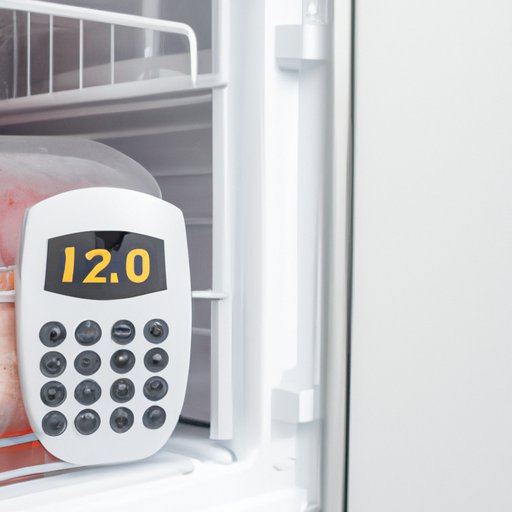Introduction
It’s no secret that refrigerators can be incredibly useful appliances. Not only do they keep food fresh and help reduce waste, but they also play an essential role in preventing foodborne illnesses. Setting and maintaining a safe refrigerator temperature is key to keeping food safe and avoiding contamination.
This article will explore the benefits of setting a safe refrigerator temperature, as well as provide an overview of the ideal temperature for refrigerators. Additionally, you’ll learn what to know about refrigerator temperature, including how to monitor and adjust your refrigerator temperature, as well as food safety tips on proper refrigerator temperature to prevent foodborne illness.

Benefits of Setting a Safe Refrigerator Temperature
Refrigerators are designed to keep food at a safe temperature that prevents bacteria from growing. Keeping food at a safe temperature is important because bacteria can grow quickly when food is left out at room temperature. This means that food stored in a refrigerator needs to be kept at a temperature that is cold enough to prevent bacterial growth, yet not so cold that it affects the quality of the food.
Setting a safe refrigerator temperature has numerous benefits. First, it helps reduce the risk of foodborne illnesses. Bacteria can cause food poisoning or other illnesses if food is left at unsafe temperatures for too long. Second, it helps keep food fresher for longer. When food is properly stored at the right temperature, it can last longer, helping to reduce food waste.
Finally, setting a safe refrigerator temperature helps ensure that food tastes better. The ideal temperature range helps preserve the flavor and texture of food, making it more enjoyable to eat.

Overview of the Ideal Temperature for Refrigerators
The ideal temperature range for most refrigerators is between 33°F and 41°F (0.5°C and 5°C). This range is considered safe for storing food, as it is cold enough to prevent bacterial growth, but not so cold that it affects the quality of the food.
Freezers should be kept at 0°F (-18°C) or lower. This is cold enough to keep food frozen indefinitely, which helps prevent spoilage and bacterial growth.
What to Know About Refrigerator Temperature
In order to ensure that your refrigerator is set at a safe temperature, it’s important to understand how to monitor and adjust your refrigerator temperature. Here are some tips:
How to Monitor and Adjust Your Refrigerator Temperature
To monitor the temperature inside your refrigerator, you should use an appliance thermometer. This will allow you to easily check the temperature inside your refrigerator and make sure it is within the safe range.
If the temperature is too high, you can adjust it by turning the temperature control knob to a cooler setting. If the temperature is too low, you can turn the knob to a warmer setting. It may take a few hours for the temperature to stabilize, so it’s best to check the temperature again after a few hours to make sure it is within the safe range.
Food Safety Tips: Refrigerator Temperature Guidelines
When storing food in the refrigerator, it’s important to follow proper food safety guidelines. Here are some tips to keep in mind:
- Keep raw meat and poultry separate from other foods to avoid cross-contamination.
- Store food in airtight containers or resealable bags to keep them fresh.
- Label and date all food so you can easily identify when it was stored.
- Eat leftovers within 3-4 days of storing them in the refrigerator.
- Check the temperature of the refrigerator regularly to make sure it is within the safe range.

Proper Refrigerator Temperature to Prevent Foodborne Illness
Maintaining the proper refrigerator temperature is essential to preventing foodborne illness. But what is foodborne illness and how can you ensure proper refrigerator temperature? Let’s take a look.
What is Foodborne Illness?
Foodborne illness, also known as food poisoning, is an illness caused by eating contaminated food. Bacteria, viruses, and parasites are common causes of foodborne illness, and can result in symptoms such as nausea, vomiting, diarrhea, and abdominal cramps.
Foodborne illnesses can be prevented by following proper food safety guidelines, such as keeping food stored at a safe temperature and avoiding cross-contamination.
How to Ensure Proper Refrigerator Temperature
To ensure that food is stored at a safe temperature, it’s important to monitor the temperature of your refrigerator regularly. You should also make sure that food is stored in airtight containers or resealable bags, and labeled and dated so you can easily identify when it was stored.
Finally, it’s important to eat leftovers within 3-4 days of storing them in the refrigerator. This will help reduce the risk of foodborne illness and keep food fresh and tasty.
Conclusion
Setting and maintaining a safe refrigerator temperature is essential to keeping food safe and preventing foodborne illnesses. By following the tips outlined in this article, you can ensure that your refrigerator is set at a safe temperature and that food is stored properly.
In summary, the benefits of setting a safe refrigerator temperature include reducing the risk of foodborne illnesses, keeping food fresher for longer, and preserving the flavor and texture of food. Additionally, it’s important to know what to know about refrigerator temperature, including how to monitor and adjust your refrigerator temperature, as well as food safety tips for proper refrigerator temperature to prevent foodborne illness.


